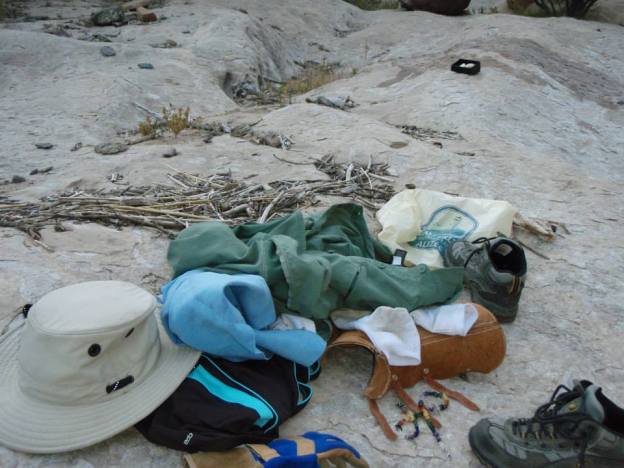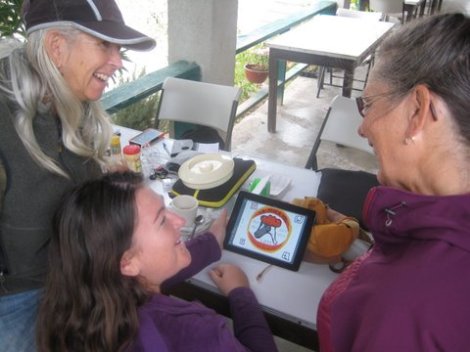Where: San Borja, Baja California, Mexico
When: February 01 2014
Who: Trudi Angell, Leslie Pringle, Nacho Chiapas, Mathilde and Andrea Murillo, Tomas Murillo
Strathmore Alberta Canada is in the heart of Canadian cowboy country. Ranches and farms abound and many of my neighbours make their living from livestock. Some even still do things the old-fashioned way by saddling up and riding out to check their cows. Not everyone can be a cowboy though, so some have regular jobs and get to ride horses in the evenings and weekends. My friend Kevin Kemps is one of those. As a horseman with more than 30 years of experience in the saddle, he is keen on all things equine and as a kind soul he likes to help folks out. He rides for fun and informally teaches those who are interested in finding out if riding is for them. On top of regular horse-riding activities, he and his horse participate in the Sam Steele Re-enactment Troop, riding in buckskin clothing and bringing parts of Canada’s western history alive. When he heard that I was going to ride a mule for a thousand miles along the length of the Baja peninsula in Mexico he was very excited.
He would have loved to come along on part of the ride, but it just wasn’t possible for him. So he did the next best thing. He sent his spurs along for an adventure. Now these aren’t regular spurs at all. These are Liberty Spurs. The rowels (the pokey things for the non-cowboy folk out there) are made from US Liberty quarters (25-cent pieces). They already had a history, having belonged to an older rider who had passed away some years before. When he died, he left them to Kevin so that the spurs could continue to have adventures. Kevin lent them to me to make sure his promise to his friend was kept.
I was touched that he would do such a thing, so I wore them with pride. It is safe to say however, that I did not wear them with much grace the first few days. I put them on upside down a time or two, some days I did them up so loosely that they flopped around or so tightly that my feet would tingle. Finally, I began to consistently get them on right the first time. It did take a little bit longer to learn to walk with them on though and not trip. If you were going to be doing a lot of walking, then yes, you would take a minute or two to take them off and strap them securely to something on you or your mule so that you could access them easily when it was time to put them back on. Sometimes though you would just be hopping off to help your mount through something extraordinarily steep or tight. Othertimes it may be because you had to “water the desert”. Trust me, if you ever want to build up your quad muscles, then squatting to pee several times a day over the course of a few months will do it. Of course, if you are a “low-squatter”, you will learn rather quickly that you need a higher position when you are wearing spurs. Nothing quite like a pointed reminder that cowgirls can’t squat too low when they are wearing spurs. Well, they can. But they shouldn’t. You only need to do that once or twice to remember to adjust your position.
The other thing you need to learn how to manage when you are wearing spurs is simple walking. It really shouldn’t be that hard to learn how to walk with them on. After all, your feet are more side-by-side than exactly behind or in front. How often do you actually put one foot right behind the other? Apparently, more often than you think. I managed to step on the spurs a number of times before I realized there is more than one reason cowboys walk bowlegged.
After the first three or four days, I pretty much had the walking with spurs on down to an art. So imagine my surprise when on November 11, after a week of riding I stepped on the left spur while walking from where I tied my mule in the shade a few feet to where we were stopping for a very brief break. I just about went arse-over-teakettle. I managed to catch myself mid-fall, hoping no one else had noticed. Of course they noticed. So, after we all laughed, we had a little snack, then mounted back up to carry on down the trail.
We were headed north, having left the lovely town of Todos Santos. We were back to camping after a two night pit stop to get more supplies and to organize ourselves for the next leg. The days, and the nights, were still hot and humid, so moving slowly and deliberately was the order of the day. Some days we were able to take a siesta, and enjoy a couple of hours in a shady place along the side of the trail.
In anticipation of a longer rest, when I dismounted for that day’s siesta, I stooped to remove my spurs. Imagine my dismay when I realized that one of the rowels was missing. Instead of having a silver quarter jingling in the shanks, I had….nothing. Just the two bars that it normally would have sat between.

Uh-oh. I broke my friend’s special spurs.
Nothing there. These weren’t my spurs. They were Kevin’s special spurs. I ruined them. And it was only one week into a four and a half month trip. What was I going to do? After standing there for a few minutes imagining all the different things that would be said to me, imagining losing a friend, having someone mad at me, I took a deep breath. I did, after all, have a few months to figure out how to fix this. I did check around where I had dismounted, just in case the rowel had fallen off right there, but no such luck.
I sat down, ate some lunch, drank some water, then laid back in the dappled shade and drifted off into a heat-induced nap.
After that, every day that we rode, I looked at these spurs. How was I going to fix this? I didn’t have an answer, I didn’t know where I could find a Liberty quarter replacement rowel. I didn’t know how Kevin was going to react.
Time and miles passed. It was now February and we were almost 500 miles further north.
On some parts of our ride, we would hire guides who knew, or at least knew how to find out, where the old trails were. In this case, we were riding along the same trails as the Meling Expedition of 1963/64 and we had the grandsons of the guide who led the team members of 50 years ago as our trailfinders. Mathilde Murillo, and his brother Tomas, had brought us around the mountain Cerro La Sandia. It was definitely the roughest country we had ridden to date. We were now at San Borja, an old mission from the days of when the missionary padres walked the trail 250 years before.
Although we chose to keep our desert mules unshod, Don Nacho preferred his mules to have shoes so that meant every once in a while they would have to be reshod. He had brought along some muleshoes, smaller versions of horseshoes, but he needed someone who could shape and apply them.
Our guides were from a large ranching family, so they knew how to shoe the mules. This was their last day with us, so before heading off back towards their home ranches, they tied the mules to a tree, slipped a leather band over each one’s eyes and worked together, as they had so many other times before, to file down the mule’s hoof, and attach a new shoe.
As they did this, I slipped my hand into my pockets and began to play with a lone two-peso coin. I wasn’t sure why it was there, on the trail you learn quickly that carrying things in your front pockets is uncomfortable. It wasn’t like there was a store here that I could have spent money at, and even if there was, two pesos (about 15 cents Canadian) wasn’t going to buy me much. There was no reason for me to even be carrying around this coin.
As I jiggled the coin, I thought of the quarter that was the rowel in my borrowed spurs. I pulled out my Mexican coin, looked at it. Then I looked at my spurs. Then at the peso coin. Then at the spurs. Then again at the coin. Slowly I lifted the spur to eye level, then I brought the peso coin up and held it next to the still intact spur. My eyes moved from the 25c piece to the peso and back. Yes, they were just about the same size. I cocked my head, then smiled and nodded to myself. This could work.

A challenge, an idea, a solution.
Kevin said he wanted his spurs to have an adventure. Well, when you travel, don’t you bring home a souvenir? Maybe his spurs could bring a souvenir back to him. Not something you see and say thanks for then put it in a drawer with all the other things you don’t know what to do with, but can’t throw away. A functional souvenir, that hopefully, will make you smile each time you see it.
Earlier in the day I had been admiring the Murillo brother’s ability to be creative in how they got things done. I decided to run my idea by Mathilde. He nodded. Si, possiblemente. Yes, possibly.
The Castro Gaxiola family looks after the mission now and as all ranchers and farmers do, have a stockpile of things that might come in handy someday. We headed over to the stockpile of surplus bits and bobs. We found an old nail, made sure it was the correct diameter to fit just right through the hole in the shank of the spurs, then he used a hammer to straighten it. Mathilde then used the nail to punch a hole through the peso coin. He threaded the nail through the first shank hole, the peso coin, then the second hole. There were still a couple of inches of nail left, so he used his pincers to worry it back and forth until it broke. But as it was smaller than the hole, the entire repair was in danger of falling apart. He then held the spur, head side of the nail down against one of the unused shoes and carefully hammered the head until the tail end of the nail had flattened and widened so that it was wide enough to hold the entire repair in place.
Kevin’s spurs were now fixed, and had their own story to tell. This jury-rigged job held up for the next 500 miles of riding through the Mexican desert and is still in place today.

Where there’s a peso, there’s a way!
What I thought about: We came up with this creative solution because we were in a remote area. There were no stores to buy a replacement piece. Would I simply have bought a replacement piece or even a replacement set of spurs if I had of had that chance? How many times in first world affluent cultures do we just go buy something new because we have lost the ability and the interest in creatively fixing something? Are we losing our ability to problem solve?
28.780100
-113.922401



















